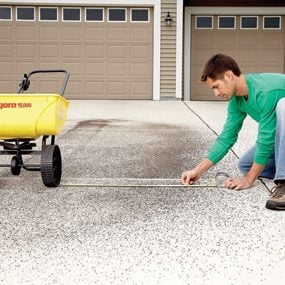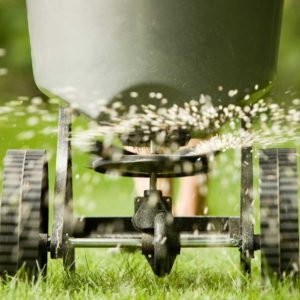How To Repair My Lawn
Lawn Care: How to Repair a Lawn
Don't give up on your lawn until you try these remedies
![]() Time
Time
Multiple Days
![]() Complexity
Complexity
Beginner
![]() Cost
Cost
$101–250
Introduction
With a combination of soil additives, fertilizers, and tender, loving care, you can alter your backyard from scraggly to golf game-course greenish in one season.
Tools Required
Materials Required
- Chicken manure
- Crabgrass preventer
- Grass seed
- Gypsum
- Herbicide
- Deadening-release fertilizer
- Soil activator
- Winterizer fertilizer
Achieving a lush grass lawn doesn't accept to be a constant struggle. And you don't have to pay large bucks for a lawn service to douse your one thousand with chemicals either. Growing healthy, dark-green grass is mainly simply a matter of knowing what to give your lawn, and when to give it.
In this story, we'll prove y'all what to do in the spring, summertime and fall to get a grass backyard so nice you could cut it up and sell information technology as sod. These steps will work for any yard, regardless of climate or soil type. The products shown in this article are available at lawn and garden centers and some home centers.
We worked with lawn care expert George Dege, ameliorate known as Mr. Lawn. He has been teaching lawn care classes since the 1970s and has helped thousands of homeowners improve their lawns.
Plus: Is lawn aeration necessary? Find out here.
Following Mr. Lawn's advice, we worked on the lawn shown hither from bound to summertime. In March, information technology had dead patches of grass caused by voles. By August, the grass over the entire lawn was so thick we felt like we were walking on a shag carpet. And the grass lawn looked great besides (meet lead photo). It was noticeably greener than the neighboring yards. We spent about $250 on supplies.

Project stride-by-step (14)
Stride 1
Spring Intendance: Vacuum the Pebbles
-
- Notation: Gravel and sand hinder grass growth, so vacuum them up.
- Start along the street and vacuum into the yard until you no longer hear stones getting sucked up.
- Then do the aforementioned matter forth the driveway.

Footstep 2
Check the Spreader's "Throw"
- To apply the right corporeality of fertilizer, measure out from the cycle to the border of the dispersal design.
- Space your passes beyond the lawn and so the coverage overlaps by half-dozen to eight inches.
- Practice this test every time you spread a new product.

Step 3
Don't Spill on the Grass
- Park your spreader over a tarp or your driveway when filling the hopper.
- Note: Spills and leaks can saturate one spot of your backyard and impale your grass.

Step 4
Employ Fertilizer Between Mowings
- Betwixt your second and tertiary leap mowings, utilize lawn fertilizer.
- Pro tip: Employ a fertilizer with ho-hum-release (time release) nitrogen.
- Follow the spread rate listed on the fertilizer bag and spread it on the unabridged lawn.
- Pro tip: For your bound and summer mowings, cut just the top third of the grass. Then if your grass is iii inches high, take 1 inch off the superlative. Mowing more than one-third stresses the grass. You can mow the grass shorter in the fall.

Step 5
Apply Soil Activator
- Fifteen days later on applying the fertilizer, spread soil activator on the lawn to assist retain water, loosen clay soils, aerate the soil, decompose grass clippings and reduce erosion.
- Notation: A forty-lb. bag covers 4,000 square feet.
- Note: Soil activator helps retain water in sandy soils and loosens clay soils. It likewise helps aerate the soil, decompose grass clippings and reduce erosion.


Vacuuming the Lawn?
"Your neighbors volition recall you lot've lost your mind when they see y'all vacuuming your lawn. But by the end of the summer, they'll be asking you for lawn care advice." — Mr. Backyard

Step vi
Late Spring, Early summertime: Measure out the Right Amount of Water
- Prepare a cake pan halfway between your sprinkler and the edge of the spray design.
- Watch your clock to see how long it takes the sprinkler to fill up the pan with 3/viii inches of water.
- H2o for that corporeality of time 3 times a week, unless it rains.
- Increase from 3/8 inch to 1/2 inch when the daytime temperatures are above eighty degrees F.

Step vii
Water with a Timer
- If you don't have an automatic sprinkler, an cheap timer frees you from watching the clock every time you lot h2o. The timer controls the sprinkler, so you'll be certain the backyard gets the proper amount of water.
- Pro tip: The best fourth dimension to water is early morning, when the sun starts to ascent. Watering at night leaves the grass moisture as well long, which can cause mucus and other diseases in the summer.

Step eight
Neutralize Dog Spots
- Wearing gloves, sprinkle a handful of gypsum over any dog spots.
- Saturate the spot with water.
- Found new grass seed in the bare spots and keep it watered.
- Note: Gypsum and water are the antidotes for dog spots in your thousand. Gypsum neutralizes the dog urine, and the h2o soaks the area for new grass seed. If you treat the brown spots early, your grass won't die.

Footstep 9
Stop Crabgrass Before It Starts
- Apply crabgrass preventer to whatsoever areas where crabgrass previously grew, which is typically along the street, driveway and sidewalk.
- Pro tip: A hand spreader is perfect for pocket-sized areas, like forth the pavement where crabgrass tends to abound.
- Note: Crabgrass volition abound when the soil warms upwardly to 55 degrees F. If y'all apply the preventer besides early, information technology will be ineffective. And once the seeds germinate, information technology's also late. In northern states, late April is the best time. Mid-March is recommended for southern states.

Stride 10
Fertilize in Late Jump
- In mid-May, requite your backyard its second awarding of backyard fertilizer.

Pace 11
Mid- to Late Summertime: Spot-Spray Individual Weeds
- If you have just a few weeds, use herbicide to afflicted areas with a pump sprayer.
- Pro tip: Be sure there's no rain in the forecast for 24 hours.

Pace 12
Use Your Hose for Large Areas of Weeds
- Pour concentrated herbicide into a punch sprayer and hook information technology upwardly to your garden hose.
- Plough the dial on the top of the sprayer to the setting recommended on the herbicide container (such equally 2 tablespoons per gallon of water).
- Spray the weeds.
- Pro tip: Spray the herbicide on a at-home day so the weed killer won't drift onto your plants and flowers.

Step 13
Utilise Chicken Manure
- In mid-August, spread chicken manure to the lawn.
- Pro tip: A 40-lb. bag covers 4,000 square feet.
- Note: You could give your lawn a third application of fertilizer, but craven manure works even better considering it contains more than nitrogen, which gives the grass a healthy, light-green wait (at that place's hardly any odor). Within ii or iii days of applying the manure, you'll run across the backyard really dark-green up.
Pace 14
Fall Lawn Care: Prep for Winter
- In early to mid-September, apply soil activator over your yard, merely every bit you did in the spring.
- Two weeks after that, give your lawn its final application of fertilizer for the year.
- Pro tip: Use a winterizer fertilizer (a twoscore-lb. bag covers ten,000 foursquare anxiety). This specialized fertilizer has more than potassium to help the roots grow deeper, which lets the roots absorb and shop nutrients until the ground freezes. When the ground warms upwards in the spring, the grass uses those nutrients to jump-start its growth.
- Continue mowing your backyard until the grass stops growing.
- On your last mowing of the year, cutting the grass to 1 to one-i/two inches high.
- Note: This reduces the chance that your lawn will get snow mold and vole damage.
- Now you lot're washed caring for your lawn until spring!

Originally Published: December 26, 2022
Source: https://www.familyhandyman.com/project/lawn-care-how-to-repair-a-lawn/

0 Response to "How To Repair My Lawn"
Post a Comment